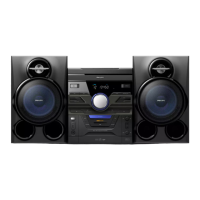
Do you have a question about the Philips FWM462 and is the answer not in the manual?
| Speaker type | 2-way |
|---|---|
| Audio amplifier | Yes |
| RMS rated power | 280 W |
| Woofer diameter | 133 mm |
| Tweeter diameter | 51 mm |
| Peak Music Power Output (PMPO) | 3600 W |
| Type | Home audio mini system |
| Cassette deck | No |
| Product color | Black, Blue |
| Disc loading type | Carousel disc loader |
| Number of optical discs | 3 discs |
| Power source | AC |
| Input voltage | 100-240 V |
| Input frequency | 50 - 60 Hz |
| Playback modes | Program, Repeat, Repeat all, Repeat one, Shuffle |
| Disc types supported | CD, CD-R, CD-RW |
| Playback disc formats | CD audio |
| Audio formats supported | MP3, WMA |
| Supported radio bands | FM, MW |
| Preset stations quantity | 40 |
| USB direct modes | Fast Forward, Fast Backward, Play/Pause, Previous/Next, Program Play, Repeat, Shuffle, Stop |
| Display type | LCD |
| Package depth | 316 mm |
|---|---|
| Package width | 1014 mm |
| Package height | 413 mm |
| Package weight | 15000 g |
| Main speaker width | 249 mm |
| Main speaker height | 344 mm |
| Main unit dimensions (WxDxH) | 265 x 403 x 310 mm |
Details audio output power, enhancement features, and speaker configuration.
Describes the main speaker system and number of loudspeakers.
Lists supported media formats and playback features for CD and USB.
Explains USB recording capabilities and sources.
Covers tuning features, station presets, and band support.
Lists microphone sockets and other audio/USB connection types.
Details alarm functions, clock display, and karaoke features.
Lists included items like antennas, adaptors, and manuals.
Provides set and packaging dimensions, weight, and speaker size.
Specifies the power supply requirements.
Shows how different board versions correspond to model variations.
Outlines the test setup for FM tuner measurements using RF generator and voltmeters.
Details AM tuner measurement setup, including Faraday cage use.
Describes the test setup for CD playback measurements.
Specifies the test setup for recorder measurements.
Warns about electrostatic discharge (ESD) sensitivity of components.
Mentions safety regulations and marking of safety components.
Provides information on identifying and handling lead-free sets.
Details critical points for returning the set to original condition after repair.
Troubleshooting flowchart for CD playback issues when the set is closed.
Recommends cleaning method for flap loaders.
Suggests adding a note for customers when the set is OK.
Details the procedure for checking CD playback compatibility.
Provides instructions for safely cleaning the CD lens.
Advises on informing customers about checks and potential issues.
Step-by-step guide for disassembling the CD module and front panel.
Instructions for disassembling the rear part of the unit.
Steps for removing specific PCB boards like AMP and USB.
Electrical schematic of the main processing and control board.
Component placement diagram for the top side of the main board.
Component placement diagram for the bottom side of the main board.
Electrical schematic of the AC power supply board.
Component placement diagram for the AC board.
Electrical schematic for the display and user interface board.
Component placement diagram for the top side of the display board.
Component placement diagram for the bottom side of the display board.
Electrical schematic for the audio amplification board.
Component placement diagram for the top side of the amplifier board.
Component placement diagram for the bottom side of the amplifier board.
Electrical schematic for the radio tuner circuit.
Component placement diagram for the tuner board.
Electrical schematic for the CD player control board.
Component placement diagram for the top side of the CD board.
Component placement diagram for the bottom side of the CD board.
Electrical schematic for the main control unit (MCU), Part 1.
Electrical schematic for the main control unit (MCU), Part 2.
Component placement diagram for the top side of the MCU board.
Component placement diagram for the bottom side of the MCU board.
